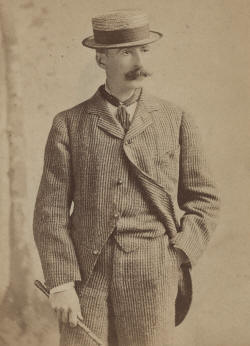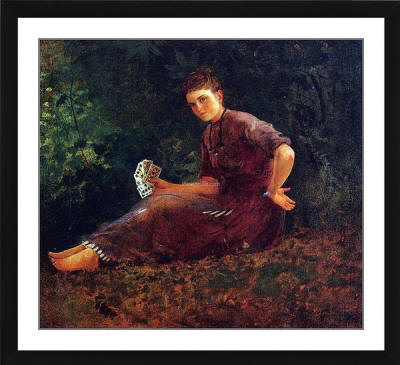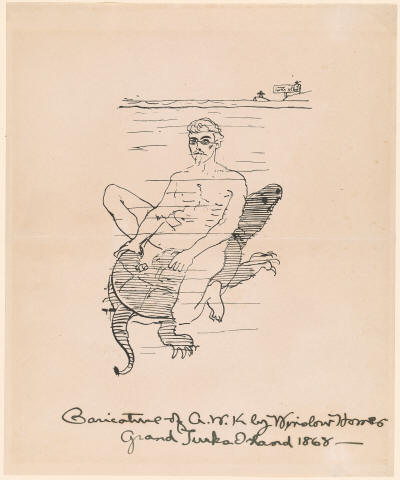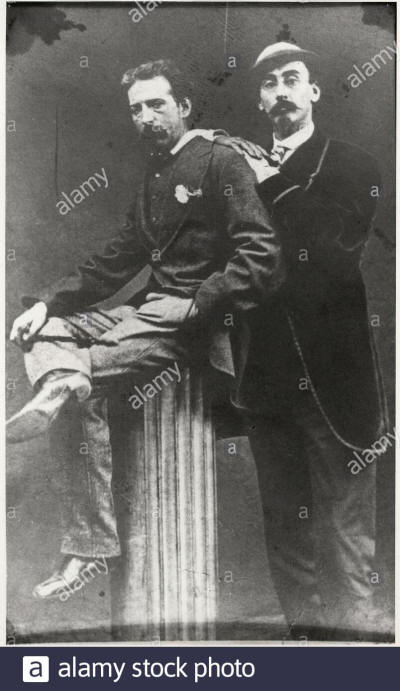

Queer Places:
Winslow Homer Studio, 5 Winslow Homer Rd, Scarborough, ME 04074
 Winslow
Homer (February 24, 1836 – September 29, 1910) was an American landscape
painter and printmaker, best known for his marine subjects. He is considered
one of the foremost painters in 19th-century America and a preeminent figure
in American art.
Winslow
Homer (February 24, 1836 – September 29, 1910) was an American landscape
painter and printmaker, best known for his marine subjects. He is considered
one of the foremost painters in 19th-century America and a preeminent figure
in American art.
Winslow Homer traveled to the Bahamas, Cuba, and Florida beginning in 1884. In Nassau, he captured the rugged musculature and masculinity of black conch and coral divers. As with John Singer Sargent, many have speculated about Homer’s sexual appetites. Homer had an intense and devoted relationship with his flatmate, Albert Kelsey, whom he drew in the Bahamas riding the back of a turtle in the nude.
In 1866, Winslow Homer sailed from Boston on the Africa for Europe. Homer spent a year in Paris, where he shared a studio in Montmartre with his friend from Belmont, Albert Warren Kelsey. Although Kelsey inscribe the back of a photography of the two of them "Damon and Pythias", alluding to the loving youths of Greek mythology, he seems in later years to have rejected his sojourn with Homer as a frivolous interlude.
Although Homer remained a bachelor for all of his 74 years, after his death, one of his close friends told biographer Lloyd Goodrich that the artist "had the usual number of love affairs." Around 40 years old, he visited friends in rural Orange County, New York, and painted several pictures of women there. One of them, titled "Shall I Tell Your Fortune?" shows a saucy-looking lass seated barefoot on the grass, holding playing cards in one hand. Her other hand rests palm-up on her hip, and her direct gaze seems to be asking the painter much more than the title suggests. Homer never attempted to sell the painting. It was still on an easel in his Prout's Neck studio when he died in 1910. Homer scholar Philip Beam thinks the mystery woman was no woman at all, but rather a boy modeling as a woman for the "girl-shy" painter. At least one reviewer has argued that Homer was homosexual.


Albert Kelsey by Winslow Homer

Winslow Homer and Albert Kelsey
Largely self-taught, Homer began his career working as a commercial illustrator.[1] He subsequently took up oil painting and produced major studio works characterized by the weight and density he exploited from the medium. He also worked extensively in watercolor, creating a fluid and prolific oeuvre, primarily chronicling his working vacations.[2][3]
Born in Boston, Massachusetts, in 1836, Homer was the second of three sons of Charles Savage Homer and Henrietta Benson Homer, both from long lines of New Englanders. His mother was a gifted amateur watercolorist and Homer's first teacher. She and her son had a close relationship throughout their lives. Homer took on many of her traits, including her quiet, strong-willed, terse, sociable nature; her dry sense of humor; and her artistic talent.[4] Homer had a happy childhood, growing up mostly in then-rural Cambridge, Massachusetts. He was an average student, but his art talent was evident in his early years.
Homer's father was a volatile, restless businessman who was always looking to "make a killing". When Homer was thirteen, Charles gave up the hardware store business to seek a fortune in the California gold rush. When that failed, Charles left his family and went to Europe to raise capital for other get-rich-quick schemes that didn't materialize.[5]
After Homer's high school graduation, his father saw a newspaper advertisement and arranged for an apprenticeship. Homer's apprenticeship at the age of 19 to J. H. Bufford, a Boston commercial lithographer, was a formative but "treadmill experience".[6] He worked repetitively on sheet music covers and other commercial work for two years. By 1857, his freelance career was underway after he turned down an offer to join the staff of Harper's Weekly. "From the time I took my nose off that lithographic stone", Homer later stated, "I have had no master, and never shall have any."[7]
Homer's career as an illustrator lasted nearly twenty years. He contributed illustrations of Boston life and rural New England life to magazines such as Ballou's Pictorial and Harper's Weekly[8] at a time when the market for illustrations was growing rapidly and fads and fashions were changing quickly. His early works, mostly commercial engravings of urban and country social scenes, are characterized by clean outlines, simplified forms, dramatic contrast of light and dark, and lively figure groupings—qualities that remained important throughout his career.[9] His quick success was mostly due to this strong understanding of graphic design and also to the adaptability of his designs to wood engraving.
Before moving to New York in 1859, Homer lived in Belmont, Massachusetts with his family. His uncle's Belmont mansion, the 1853 Homer House, was the inspiration for a number of his early illustrations and paintings, including several of his 1860s croquet pictures. The Homer House, owned by the Belmont Woman's Club, is open for public tours.
In 1859, he opened a studio in the Tenth Street Studio Building in New York City, the artistic and publishing capital of the United States. Until 1863, he attended classes at the National Academy of Design, and studied briefly with Frédéric Rondel, who taught him the basics of painting.[10] In only about a year of self-training, Homer was producing excellent oil work. His mother tried to raise family funds to send him to Europe for further study but instead Harper's sent Homer to the front lines of the American Civil War (1861–1865), where he sketched battle scenes and camp life, the quiet moments as well as the chaotic ones.[11] His initial sketches were of the camp, commanders, and army of the famous Union officer, Major General George B. McClellan, at the banks of the Potomac River in October 1861.
Before exhibiting at the National Academy of Design, Homer finally traveled to Paris, France in 1867 where he remained for a year. His most praised early painting, Prisoners from the Front, was on exhibit at the Exposition Universelle in Paris at the same time.[12] He did not study formally but he practiced landscape painting while continuing to work for Harper's, depicting scenes of Parisian life.
Homer spent two years (1881–1882) in the English coastal village of Cullercoats, Tyne and Wear. Many of the paintings at Cullercoats took as their subjects working men and women and their daily heroism, imbued with a solidity and sobriety which was new to Homer's art, presaging the direction of his future work.[8] He wrote, "The women are the working bees. Stout hardy creatures."[27] His works from this period are almost exclusively watercolors.[28] His palette became constrained and sober; his paintings larger, more ambitious, and more deliberately conceived and executed. His subjects more universal and less nationalistic, more heroic by virtue of his unsentimental rendering. Although he moved away from the spontaneity and bright innocence of the American paintings of the 1860s and 1870s, Homer found a new style and vision which carried his talent into new realms.[29]
Back in the U.S. in November 1882, Homer showed his English watercolors in New York. Critics noticed the change in style at once, "He is a very different Homer from the one we knew in days gone by", now his pictures "touch a far higher plane ... They are works of High Art."[30] Homer's women were no longer "dolls who flaunt their millinery" but "sturdy, fearless, fit wives and mothers of men" who are fully capable of enduring the forces and vagaries of nature alongside their men.[31]
In 1883, Homer moved to Prouts Neck, Maine (in Scarborough), and lived at his family's estate in the remodeled carriage house seventy-five feet from the ocean.[32] During the rest of the mid-1880s, Homer painted his monumental sea scenes. In Undertow (1886), depicting the dramatic rescue of two female bathers by two male lifeguards, Homer's figures "have the weight and authority of classical figures".[33] In Eight Bells (1886), two sailors carefully take their bearings on deck, calmly appraising their position and by extension, their relationship with the sea; they are confident in their seamanship but respectful of the forces before them. Other notable paintings among these dramatic struggle-with-nature images are Banks Fisherman, The Gulf Stream, Rum Cay, Mending the Nets,, and Searchlight on Harbor Entrance, Santiago de Cuba. Some of these he repeated as etchings.[34]
At fifty years of age, Homer had become a "Yankee Robinson Crusoe, cloistered on his art island" and "a hermit with a brush". These paintings established Homer, as the New York Evening Post wrote, "in a place by himself as the most original and one of the strongest of American painters."[32] But despite his critical recognition, Homer's work never achieved the popularity of traditional Salon pictures or of the flattering portraits by John Singer Sargent. Many of the sea pictures took years to sell and Undertow only earned him $400.[35]
By 1900, Homer finally reached financial stability, as his paintings fetched good prices from museums and he began to receive rents from real estate properties. He also became free of the responsibilities of caring for his father, who had died two years earlier.[44] Homer continued producing excellent watercolors, mostly on trips to Canada and the Caribbean. Other late works include sporting scenes such as Right and Left, as well as seascapes absent of human figures, mostly of waves crashing against rocks in varying light. His late seascapes are especially valued for their dramatic and forceful expression of natures powers, and for their beauty and intensity.[45]
In his last decade, he at times followed the advice he had given a student artist in 1907: "Leave rocks for your old age—they're easy."[46]
Homer died in 1910 at the age of 74 in his Prouts Neck studio and was interred in the Mount Auburn Cemetery in Cambridge, Massachusetts. His painting, Shooting the Rapids, Saguenay River, remains unfinished.
His Prouts Neck studio, a National Historic Landmark, is now owned by the Portland Museum of Art, which offers tours.[47]
My published books: